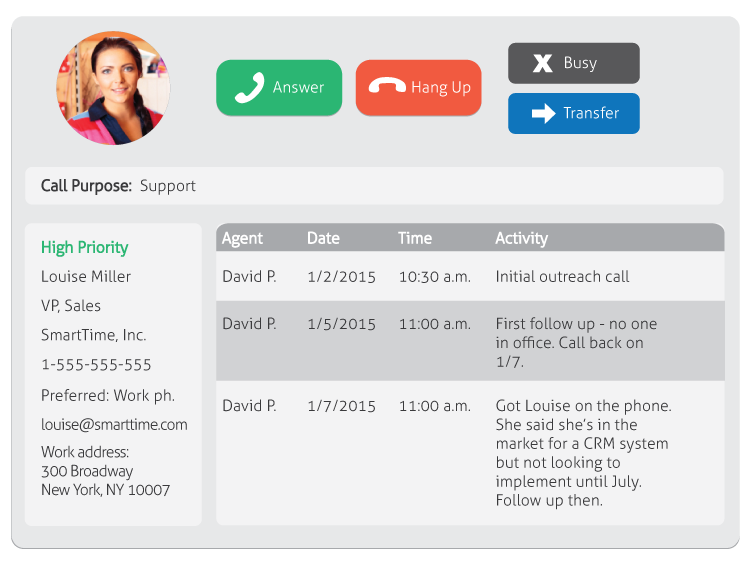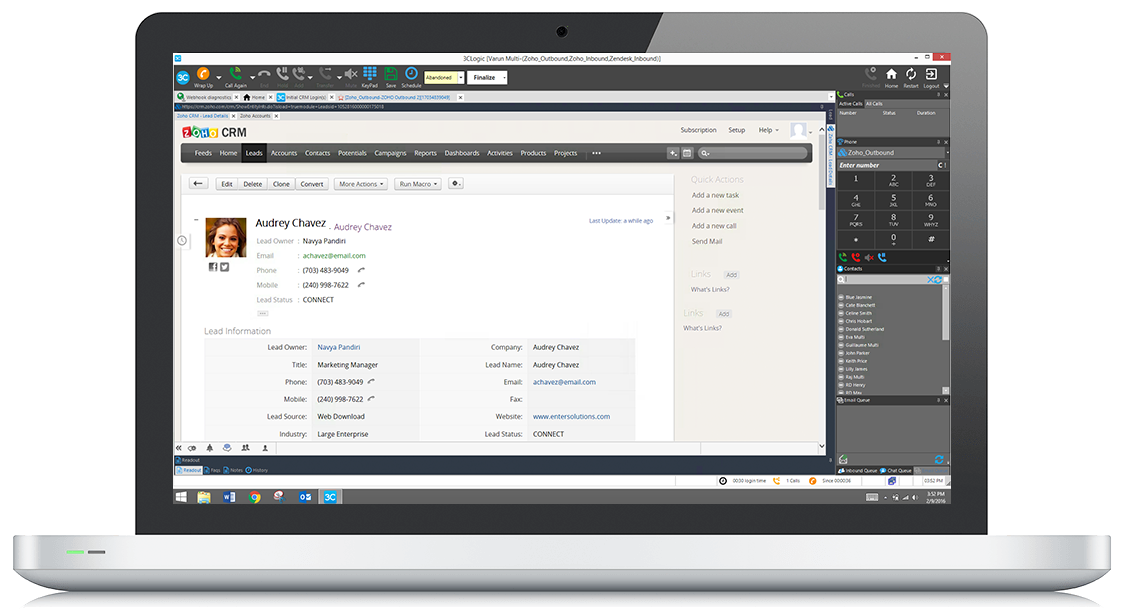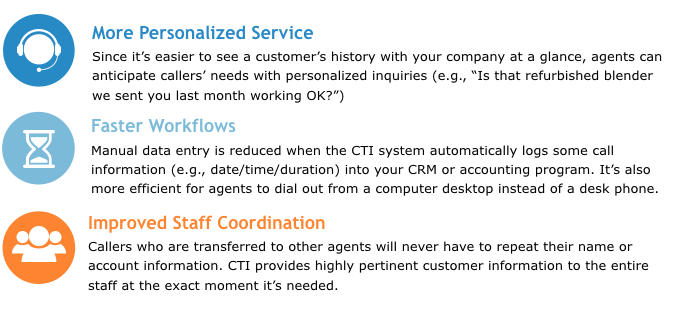Find the best Computer Telephony Integration Software
Compare Products
Showing 1 - 20 of 255 products
Sort by
Reviews: Sorts listings by the number of user reviews we have published, greatest to least.
Sponsored: Sorts listings by software vendors running active bidding campaigns, from the highest to lowest bid. Vendors who have paid for placement have a ‘Visit Website’ button, whereas unpaid vendors have a ‘Learn More’ button.
Avg Rating: Sorts listings by overall star rating based on user reviews, highest to lowest.
A to Z: Sorts listings by product name from A to Z.
Zendesk Suite
Zendesk Suite
Zendesk is a cloud-based help desk management solution offering customizable tools to build customer service portal, knowledge base and online communities. The solution offers a customizable front-end portal, live chat features an...Read more about Zendesk Suite
Nextiva Contact Center
Nextiva Contact Center
Create more powerful customer experiences while reducing cost and complexity so you can grow your customer relationships, empower your agents, and delight your customers. Serve customers where they are and when they want with tr...Read more about Nextiva Contact Center
Talkdesk
Talkdesk
Talkdesk is a cloud-based call center solution that helps businesses improve customer satisfaction while simultaneously reducing customer support costs. It uses interactive voice response (IVR), automatic call distribution (ACD) a...Read more about Talkdesk
CallTools
CallTools
CallTools offers an advanced predictive dialer and inbound call center management solution that streamlines and optimizes call center operations. With list management tools that include list scrubbing, recycling, and export capabi...Read more about CallTools
Talk with us for a free
15-minute consultationSoftware Advice is free because vendors pay us when they receive sales opportunities.
This allows us to provide comprehensive software lists and an advisor service at no cost to you.
This allows us to provide comprehensive software lists and an advisor service at no cost to you.
Meet Eric, a software expert who has helped 1,534 companies select the right product for their needs.
Talk with us for a free
15-minute consultationSoftware Advice is free because vendors pay us when they receive sales opportunities.
This allows us to provide comprehensive software lists and an advisor service at no cost to you.
This allows us to provide comprehensive software lists and an advisor service at no cost to you.
Tell us more about your business and an advisor will reach out with a list of software recommendations customized for your specific needs.
STEP 1 OF 4
How many users do you have?
Five9
Five9
Five9 is an all-in-one cloud contact center solution for inbound, outbound, blended and omnichannel contact centers world-wide. Powered by Practical AI, Five9 enables agents to provide customer experiences across phone, emai...Read more about Five9
Dialpad
Dialpad
Dialpad is an AI-powered cloud communication platform and business phone system that provides organizations with the latest in VoIP telephony technology to keep teams connected and productive. The platform comprises three integrat...Read more about Dialpad
GoTo Connect
GoTo Connect
GoTo Connect is the all-in-one phone, meeting and messaging software built for SMBs. It boasts an enterprise-class phone system with 100+ features with inclusive minutes for local, long distance & international calls; video and au...Read more about GoTo Connect
DialedIn CCaaS
DialedIn CCaaS
DialedIn (formerly ChaseData) offers cloud-based, standalone call center functionality with customer service and support built into the solution. It’s designed for outbound, inbound and blended call center teams. Dialing capabil...Read more about DialedIn CCaaS
Zoho Desk
Zoho Desk
Zoho Desk is a cloud-based help desk solution from Zoho Corporation, catering to businesses of all sizes. Key features include management of customer support tickets, a customer support portal, contract management and report creat...Read more about Zoho Desk
RingCentral MVP
RingCentral MVP
RingEX is a cloud-based business communications solution that offers tools for Messaging, Video and Phone. Core features of the solution include conferencing, auto-recording and unlimited long-distance and local calling. RingEX ...Read more about RingCentral MVP
Nextiva
Nextiva
Nextiva brings customers and teams closer by connecting conversations in one AI-powered platform. We connect businesses to all of their conversations, helping them understand their customers in real-time to create personalized exp...Read more about Nextiva
Bitrix24
Bitrix24
Bitrix24 is an online workspace for small, medium, and large businesses. It features over 35 cross-integrated tools, including CRM, tasks, Kanban board, Gantt chart, messenger, video calls, file storage, workflow automation, and m...Read more about Bitrix24
VoIP.ms
VoIP.ms
VoIP.ms is a cloud-based internet phone service solution designed to help businesses manage local, mobile and toll-free number portability across Canada and United States. Key features include voicemail, call waiting, caller ID, D...Read more about VoIP.ms
Google Voice
Google Voice
Google Voice is a cloud-based business phone system that provides users with a unique contact number to receive international calls, send text messages and transcribe voicemails, streamlining communications across the organization...Read more about Google Voice
NICE CXone
NICE CXone
Organizations around the world are striving to deliver the ultimate customer experience, strengthen brand value, and boost efficiency. NICE CXone empowers brands to achieve these objectives on one interaction-centric platform with...Read more about NICE CXone
CallHippo
CallHippo
CallHippo is a cloud-based call center solution that helps mid to large size businesses with workflow automation and virtual telephony. The platform enables users to give detailed analysis to customers through call recordings. Cal...Read more about CallHippo
Twilio
Twilio
Twilio is the worlds leading cloud communications platform that enables businesses to build, scale, and operate their own customized communication solutions. The platform is designed to be customizable and easy to use, which means...Read more about Twilio
Aircall
Aircall
Aircall is a cloud-based business phone and call center system that helps manage and streamline customer support and sales engagement operations. Designed for offices and teams in remote areas, it enables users to integrate the so...Read more about Aircall
3CX
3CX
3CX Phone System is an open standards communications solution, suitable for any sized business that wants all the features of an advanced contact center at a fraction of the cost. 3CX can take your business communications to the n...Read more about 3CX
Ringover
Ringover
Ringover is the no.1 business phone system that gives you unlimited calls to 110 countries, video conferencing, SMS and group messaging, call recording, call whispering and more features focused on improving your teams productivit...Read more about Ringover
Popular Comparisons
Buyers Guide
Last Updated: March 16, 2023Imagine you’re an agent at a busy call center: you’re fielding dozens of phone calls a day with customers you’ve never met, and you want to make a good impression on all of them. Don’t you want to be as prepared and efficient as possible?
One of the best ways to set up your call center team for success in the environment described is by investing in a system with computer telephony integration (CTI). CTI is an important category of call center software: It enables phone and computer systems to work together for the benefit of your agents and your customers.
In this guide, we’ll break down everything you need to know to choose the right CTI system for your company, such as:
What Is CTI?
CTI, or computer telephony integration, is also known as “computer-telephone integration” or “computer telephony.” These terms may sound intimidating, but their basic meaning is straightforward: CTI is technology that lets you use a computer to initiate, manage and enhance your phone calls.
CTI is often used as a jargon term for describing integrations between a phone system and a customer relationship management (CRM) system that has already been deployed. These integrations add features to enhance both systems and help agents better handle interactions.
An example of how they do this is “screen pops”—a window that pops up on an agent's computer screen when they have an incoming phone call. That window displays information about the caller, e.g., address and interaction history, which is pulled from the call center’s existing CRM program.

This is what a screen pop might look like in a typical CTI solution.
This phone system-computer coordination is made possible through CTI. Though it’s most common for CTI to be used for CRM integrations, it is also good for other types of integrations.
For instance, many organizations now use CTI to allow their accounting software to interface with their phone system. Agents can call customers with unpaid invoices directly from their accounting software through functionality called “click-to-dial” (more details on this below).
To recap: CTI software acts as a bridge for the exchange of data and functionalities between a company’s phone system and other existing programs, such as CRM or accounting solutions.
Common Functionality of CTI
Vendors offer a variety of functional breadth and depth in their CTI solutions. Here are some of the most common capabilities:
Screen pops | In addition to what we’ve already described, screen pops can indicate the priority level of an interaction with a caller based on customer history data from your CRM program. They can also use a customer’s Interactive Voice Response (IVR) system answers to display the purpose of a call (e.g., sales or support). |
Click-to-dial | This function adds outbound dialing capabilities to the databases of contacts you'd find in a CRM or accounting system. Agents can skip manual dialing and simply click a phone number on their computer screen to place a call. |
Caller authentication | CTI software screens incoming calls and uses the phone number to find a match in your CRM system. It can confirm the caller’s identity before the call even starts. |
Phone controls | Users can manage their phone controls through the computer instead of dialing buttons manually. These include the ability to answer, hang-up, conference, forward and transfer calls. |
Logging and notes | Basic information is automatically logged in the CRM system while the call is in progress, such as the time/date of the call and agent handling it. Agents can also add manual notes directly into the CRM or accounting program. |
Coordinated voice/data transfer | If a call needs to be transferred from one member of your team to another, this function allows all onscreen customer information (e.g., screen pops) to be transferred when the line is reassigned. |

3CLogic and Zoho CRM integration showing the “click-to-dial” function
CTI Benefits
Here are some benefits that explain how CTI can empower call center agents and companies to have more productive customer interactions:
Top Benefits of CTI Software

CTI Implementation Options
CTI can be implemented in one of two ways:
As a best-of-breed application
As part of a call center suite that has CTI capabilities built in, in addition to other applications (e.g., automatic call distribution or workforce scheduling)
It’s important to note that best-of-breed CTI software is a relatively niche offering. It could be a good option for companies with older phone systems who aren’t ready to buy a new one just yet, but still want to reap the benefits of CTI sooner rather than later.
The vast majority of buyers are better off with the second option: You’ll need an established phone system for calls to be able to work on your computers at all. It’s easier to implement a phone system that supports CTI from the start, rather than trying to retrofit or replace it later on.
Also worth noting: Some of the more basic CTI capabilities (e.g., click-to-dial and even screen pops, in some cases) can be achieved with a PBX system as an alternative to using CTI with a call center system.
Integration Considerations
Once you’ve decided on an implementation model, you can evaluate vendors. As we’ve explained, CTI is intended to be used with computer programs that call centers are already using, such as existing CRM or accounting systems. It’s important to ensure that any CTI vendor on your shortlist can interface with this existing software. You can usually find this information listed on vendors’ websites.







